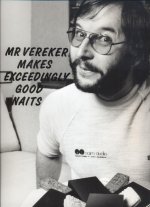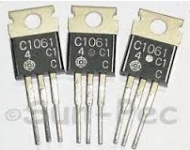Member
Joined 2009
Paid Member
At 1830 audio devices per year you are able to create and record statistics
English made or English style made amplifiers come to the shop normally because are broken while their capacitors hardly ever need replacements either since these are not so old or haven't been used that much
After reading your comments coming from someone who actually services all makes of amplifiers, I'm certainly glad I've never wasted my money on a Naim, Arcam or any of the other ridiculously overpriced, poorly designed British amplifiers.
They do seem to have a loyal following though for whatever reason.
But then again, so did Jim Jones and David Koresh.😀
After reading your comments coming from someone who actually services all makes of amplifiers, I'm certainly glad I've never wasted my money on a Naim, Arcam or any of the other ridiculously overpriced, poorly designed British amplifiers.
They do seem to have a loyal following though for whatever reason.
But then again, so did Jim Jones and David Koresh.😀
Don't think that Japanese amplifiers don't also have flaws , mistakes and in some cases some of them planted ...Point is that hardly ever these flaws have much to do with stability or safety .
Pretty simple to understand here is bigun working , Wahab is correcting , Sakis is adding smoky feedback , and Andrew T will find the mistakes of all .
In a Japanese team there should be like a 100 ppl minimum working on the circuit .
Anyone expects that in NAim there is 100 ppl design team???? ...well i don't think so
Indeed. If you were prepared to change tack and rework the project as yet another blameless design, it would have been pointless too. As it is, the distortion profile may not be perfect but it's going to sound a lot better than if it presented as a balanced LTP usually does; suppressing even harmonics and leaving the odd harmonics unaffected.....We're looking to make a circuit like the old Naim amp. If we want to make an amplifier with lower distortion that would be a different project (look up my TGM7, TGM8 amps).
Member
Joined 2009
Paid Member
Not all is lost with the LTP as there are 'tricks' you can employ to get an engaging sound. My TGM1 uses tricks learned from AKSA (originally from an RCA approach and tweaked, something in common between Hugh and JV). Or you can do tricks with the VAS (e.g. The bootstrap) and so on. We have many tools at our disposal once you know what they can do and what you are trying to achieve of course. Nevertheless, for punchy bass the LTP usually requires a high feedback design to keep the differential signal small as possible.
Last edited:
Not all is lost with the LTP as there are 'tricks' you can employ to get an engaging sound. My TGM1 uses tricks learned from AKSA (originally from an RCA approach and tweaked, something in common between Hugh and JV). Or you can do tricks with the VAS (e.g. The bootstrap) and so on. We have many tools at our disposal once you know what they can do and what you are trying to achieve of course. Nevertheless, for punchy bass the LTP usually requires a high feedback design to keep the differential signal small as possible.
As I see it the 22k value is there by design. I commented to that effect on another thread a while ago. I followed this thread for a while afterwards and see the value was changed to 4k7 in a more recent version of the circuit.
This is complete nonsense and a myth that keeps being repeated. I have been involved in two businesses with international profiles and product reviews in a wide variety of hi-fi publications. Never once has a review been linked to advertising spend, or a free product been required. The magazines need the products to review, that's what drives their readership.
These magazines also need to keep profit as high as possible, not least by selling as many ads as possible. Are you really trying to tell us that a manufacturer still wants to spend any money for ads in the same magazine that put bad reviews for some of his products? This was exactly the reason why the well reputated (for their objective measurements and the absence of audiophoolish blah-blah) German Magazine HiFi Stereophonie folded about three decades ago.
Best regards!
Member
Joined 2009
Paid Member
The photos we have of early NAP products show clearly that the value is 22k and that's the value I will be using.this thread for a while afterwards and see the value was changed to 4k7 in a more recent version of the circuit.
The photos we have of early NAP products show clearly that the value is 22k and that's the value I will be using.
Understandably.
Member
Joined 2009
Paid Member
My power transformer is stuck. I was due to pick it up from a colleage but my trip was cancelled by a winter storm. Darn.
Member
Joined 2009
Paid Member
the boards have been completed and are on their way
I'll have to finalize my parts order pretty soon
I'll have to finalize my parts order pretty soon
Member
Joined 2009
Paid Member
Hi Bigun
Sorry for this way out post,but any further news on this project?Your projects are usually a lot more conclusive and always a joy to read the way you go about it.
I see you've started a new thread(TGM11) and that is why I'm asking.Apologies if I missed something important with regards to this thread.The Naim amps always held a little bit of fascination for me as well and I liked the idea with your approach.
Regards
phunk
Sorry for this way out post,but any further news on this project?Your projects are usually a lot more conclusive and always a joy to read the way you go about it.
I see you've started a new thread(TGM11) and that is why I'm asking.Apologies if I missed something important with regards to this thread.The Naim amps always held a little bit of fascination for me as well and I liked the idea with your approach.
Regards
phunk
Member
Joined 2009
Paid Member
Hi phunk,
I'm still waiting for the pcb's to arrive from China. Normally it doesn't take so long. I will probably send them a message soon to alert them to the concern. So whilst I was waiting I thought I'd start thinking about another project !
Anyhow, this project has not been abandoned, it will be built !
The other thing is that I have a business trip coming up which means more delays. Oh well, it'll be all the sweeter once everything is ready 🙂
I'm still waiting for the pcb's to arrive from China. Normally it doesn't take so long. I will probably send them a message soon to alert them to the concern. So whilst I was waiting I thought I'd start thinking about another project !
Anyhow, this project has not been abandoned, it will be built !
The other thing is that I have a business trip coming up which means more delays. Oh well, it'll be all the sweeter once everything is ready 🙂
I know exactly how it feels while waiting for stuff from China.I think its the Chinese New Year that's making stuff takes so long to arrive.I'm also waiting on some orders(have mailed them earlier this week-no reply yet),+living in South Africa it can become a heavy gamble and waiting game for items to arrive.
I persevere though as most items are too expensive or fake to buy locally even though it takes a very long time to finish projects.
I will stay locked on this thread and follow TGM11 as well.
Regards
phunk
I persevere though as most items are too expensive or fake to buy locally even though it takes a very long time to finish projects.
I will stay locked on this thread and follow TGM11 as well.
Regards
phunk
Member
Joined 2009
Paid Member
An EF OS would have lower THD, what the quasi complementay does is to increase distorsion with even harmonics being increased more than odd ones...
I believe that there are more to amplifiers (design) than just the distortion.
As for the distortion, well this is one of the key things about the amp that makes it what it is.
May be the signature is inherited from the transistors used. Probably the output transistor.
I have never heard a Naim clone, which sounded better than the original ones. Not even mine. I do not know why that is so
Unfortunately I have never heard the Naim amp. But I can hear that amplifiers sound very different to each other, but fortunately, I have no interest in any kind of "effect box". So if an amp sounded "different" I don't think that I would use the word "sound better" to describe it.
Or wait, what Naim amp we are talking about here? NAP250? I can use Youtube to hear and judge the sound quality of it.
Okay, so I have heard the Naim through youtube video. So coloured and I don't like it. But I guess if I want to get that sound signature, I will use the Hitachi 2SC1061 in TO-220 package. This is vintage transistor but I think is still easy to find.
Okay, so I have heard the Naim through youtube video. So coloured and I don't like it. But I guess if I want to get that sound signature, I will use the Hitachi 2SC1061 in TO-220 package. This is vintage transistor but I think is still easy to find.
Attachments
Last edited:
Mas Dedego,
An 'effects box' and a pure undistorted, zero THD are at the opposite ends of the spectrum.
Like most human beings, you might prefer something between rather than the extremes.
yth,
Hugh
An 'effects box' and a pure undistorted, zero THD are at the opposite ends of the spectrum.
Like most human beings, you might prefer something between rather than the extremes.
yth,
Hugh
- Status
- Not open for further replies.
- Home
- Amplifiers
- Solid State
- TGM10 - based on NAIM by Julian Vereker





